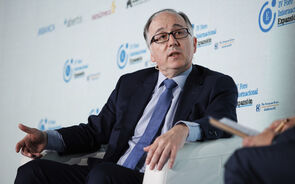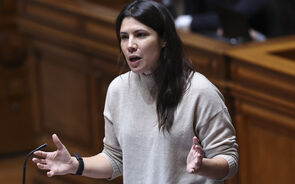Trend following: discussão de sistemas de trading
Obrigado LTCM. Excelente entrevista. Já tinha gostado bastante da que ele deu no New Market Wizards, mas esta tem, quanto a mim, mais sumo (ainda que bastante codificado - há parágrafos que se têm de ler várias vezes e ficar a pensar no que é que ele quer dizer). Muito focado no risk management, tal como outros traders (o Monroe Trout era (é ?) provavelmente outro bom exemplo da obsessão com o risco).
Pena que não lhe tenham a feito a pergunta que gostava de fazer a todos estes tipos da velha guarda -> se têm sentido alguma modificação no comportamento do mercado / sistemas com o aparecimento do HFT.
Pena que não lhe tenham a feito a pergunta que gostava de fazer a todos estes tipos da velha guarda -> se têm sentido alguma modificação no comportamento do mercado / sistemas com o aparecimento do HFT.
No man is rich enough to buy back his past - Oscar Wilde
luissm Escreveu:Mesmo para Forex? É que não é um mercado que apresente muitas tendências.
O sitema é o mesmo para qualquer activo (sem qualquer tipo de curve-fitting). É um sistema robusto. Se não o fosse bastaria mudar o activo que o sistema deixaria de apresentar resultados.
---Tudo o que for por mim escrito expressa apenas a minha opinião pessoal e não é uma recomendação de investimento de qualquer tipo---
https://twitter.com/JCSTrendTrading
"We can confidently predict yesterdays price. Everything else is unknown."
"Every trade is a test"
"Price is the aggregation of everyone's expectations"
"I don't define a good trade as a trade that makes money. I define a good trade as a trade where I did the right thing". (Trend Follower Kevin Bruce, $5000 to $100.000.000 in 25 years).
https://twitter.com/JCSTrendTrading
"We can confidently predict yesterdays price. Everything else is unknown."
"Every trade is a test"
"Price is the aggregation of everyone's expectations"
"I don't define a good trade as a trade that makes money. I define a good trade as a trade where I did the right thing". (Trend Follower Kevin Bruce, $5000 to $100.000.000 in 25 years).
luissm Escreveu:Mesmo para Forex? É que não é um mercado que apresente muitas tendências.
Tens a certeza?!
http://caldeiraodebolsa.jornaldenegocio ... &start=571
"People want to be told what to do so badly that they'll listen to anyone." - Don Draper, Mad Men
Boas JCS,
Já agora nas Commodities recorres a que tipo de instrumentos, Futuros, ETF’s ou CFD’s?
Qualquer um deles.
Usas o mesmo sistema com base no Price Channel Breakout que falamos no tópico da Apple, para as commodities?
´
É o mesmo sistema para negociar qualquer tipo de activo, basta que tenha preço...
JCS
---Tudo o que for por mim escrito expressa apenas a minha opinião pessoal e não é uma recomendação de investimento de qualquer tipo---
https://twitter.com/JCSTrendTrading
"We can confidently predict yesterdays price. Everything else is unknown."
"Every trade is a test"
"Price is the aggregation of everyone's expectations"
"I don't define a good trade as a trade that makes money. I define a good trade as a trade where I did the right thing". (Trend Follower Kevin Bruce, $5000 to $100.000.000 in 25 years).
https://twitter.com/JCSTrendTrading
"We can confidently predict yesterdays price. Everything else is unknown."
"Every trade is a test"
"Price is the aggregation of everyone's expectations"
"I don't define a good trade as a trade that makes money. I define a good trade as a trade where I did the right thing". (Trend Follower Kevin Bruce, $5000 to $100.000.000 in 25 years).
Destaco este parágrafo na entrevista do Bill Eckhardt:
FM: Many of the turtles have gone on to great success as well as some of the C&d traders, even though their strategies have evolved into something quite different than the original. Was there something more basic in the lessons that allowed so many to succeed and create new strategies?
BE: The turtles were stringently selected and highly talented. They also received training, practice and guidance. They got a good start from us, but they deserve most of the credit for their ongoing success. The successful turtles have branched out widely, but my trading has also changed; it’s evolve or perish...
As I recall, more than half of the course revolved around developing the right attitude, guarding against debilitating emotions, how to think about risk and how to handle success and failure…Teaching the turtle system itself doesn’t take very long. Attitude, emotional control, discipline; those things are harder to teach.
---Tudo o que for por mim escrito expressa apenas a minha opinião pessoal e não é uma recomendação de investimento de qualquer tipo---
https://twitter.com/JCSTrendTrading
"We can confidently predict yesterdays price. Everything else is unknown."
"Every trade is a test"
"Price is the aggregation of everyone's expectations"
"I don't define a good trade as a trade that makes money. I define a good trade as a trade where I did the right thing". (Trend Follower Kevin Bruce, $5000 to $100.000.000 in 25 years).
https://twitter.com/JCSTrendTrading
"We can confidently predict yesterdays price. Everything else is unknown."
"Every trade is a test"
"Price is the aggregation of everyone's expectations"
"I don't define a good trade as a trade that makes money. I define a good trade as a trade where I did the right thing". (Trend Follower Kevin Bruce, $5000 to $100.000.000 in 25 years).
Re: The man who launched 1,000 systems
LTCM Escreveu:Não sei se já passou por aqui, e como os fãs são tantos...
Thanks LTCM!
JCS
---Tudo o que for por mim escrito expressa apenas a minha opinião pessoal e não é uma recomendação de investimento de qualquer tipo---
https://twitter.com/JCSTrendTrading
"We can confidently predict yesterdays price. Everything else is unknown."
"Every trade is a test"
"Price is the aggregation of everyone's expectations"
"I don't define a good trade as a trade that makes money. I define a good trade as a trade where I did the right thing". (Trend Follower Kevin Bruce, $5000 to $100.000.000 in 25 years).
https://twitter.com/JCSTrendTrading
"We can confidently predict yesterdays price. Everything else is unknown."
"Every trade is a test"
"Price is the aggregation of everyone's expectations"
"I don't define a good trade as a trade that makes money. I define a good trade as a trade where I did the right thing". (Trend Follower Kevin Bruce, $5000 to $100.000.000 in 25 years).
Olá JCS,
tenho 3 questões,
1ª ao só se arriscar 2% por trade e ao mesmo tempo se aceitar um DD de por ex.15%,é necessário uma valorização de 15% para termos 2% de ganho,certo?
Não, o DD de 15% diz respeito ao total da Equity da carteira e não em relação à movimentação do activo.
Em termos de TF,qual o nº de trades abertos ao mesmo tempo, que será aconselhavel ter?
Não há um número que seja ótimo até porque só se abrem posições quando há indicação para tal e não porque temos de ter "X" número de trades abertos por ser aconselhável. Teoricamente (acho que até foi colocado aqui no fórum) penso que a partir de 15 posições não há ganhos em termos de diversificação... mas não se força nada (ou há sinais de entrada ou não há).
2ª em termos de piramidagem,para o risco não aumentar
o stop tem que ir subindo,certo?
Certo.
Esta subida é tendo em conta só a % do risco,ou a analise tecnica é que manda,ex.MMoveis e ai tu aceitares ir até aos 4%?
A maneira que uso tem em conta a volatilidade de cada activo. Para activos mais voláteis a subida tem de ser maior para adicionar posições e ajustar stops. Para activos menos voláteis uma movimentação menor é suficiente. No entanto poderão haver outros métodos que têm em conta outros parâmetros e serem perfeitamente válidos. Cada um que escolha o seu.
Os 4% é o risco máximo por activo (segundo o meu método) que para mim fica em aberto até um certo momento quando começo a piramidar. Após uma certa fase o risco diminui até ficar anulado (quando as trends dão espaço para um melhor ajuste de stops).
3ª qual o máximo de DD que se poderá aceitar sem
invalidar que a nossa análise está errada?
Por trade eu estou disposto a perder 2% da Equity para ver se tenho ou não razão (é o risco/trade). Os DD (acumulação de perdas de vários trades) depende de cada trader. Há quem suporte DDs de -30% sem pestanejar nem lhe afectar uma pinga de humor e há outros que ter um DD de -10% da carteira é uma autêntica catástrofe, entram em depressão e total desânimo e nunca mais querem ver titulos há frente.
Todos os grandes traders (já o li em várias publicações) tem a opinião que quando os seus clientes dizem que aguentam sem problemas DDs de -30% na realidade aos -15% já estão desesperados... Presumo que para qualquer um de nós se passe a mesma coisa por essa razão sejam conservadores no DD que estimam conseguir tolerar. Isto não é algo que se consiga afinar em paper trading. Tem de se sentir mesmo a "dôr" do Real money e ajustar, ajustar e ajustar.
Se o DD vos começar a preocupar é talvez porque pensavam que 2% por trade era o risco ideal para vocês mas que se revela afinal risco a mais. Ajustem o risco e experimentem começar a negociar com 1,50% ou 1,0% ou 0,50%/trade. O objectivo é estarmos confortáveis TODOS os dias do ano. Trading não é para andar a roer as unhas porque é neste estado de espírito que se cometem todo o tipo de erros e mais alguns (passamos a vender sem termos sinal para isso, a tentar "afinar" o método, etc). Depois também há quem negoceie com 4 e 5%/trade e ande feliz da vida...
Dois traders que usassem precisamente o mesmo método e negociassem os mesmos mercados deveriam ter teoricamente os mesmos resultados. No entanto um poderia estar completamente feliz da vida enquanto outro poderia andar completamente rebentado emocionalmente com a "montanha-russa" que normalmente é o trading. Como tal, para cada trader o seu próprio método. O método tem de estar ajustado à personalidade de cada um, senão não o vão ser capazes de cumprir. O que descrevo é o que funciona para mim e para a minha personalidade.
Cumprimentos
JCS
---Tudo o que for por mim escrito expressa apenas a minha opinião pessoal e não é uma recomendação de investimento de qualquer tipo---
https://twitter.com/JCSTrendTrading
"We can confidently predict yesterdays price. Everything else is unknown."
"Every trade is a test"
"Price is the aggregation of everyone's expectations"
"I don't define a good trade as a trade that makes money. I define a good trade as a trade where I did the right thing". (Trend Follower Kevin Bruce, $5000 to $100.000.000 in 25 years).
https://twitter.com/JCSTrendTrading
"We can confidently predict yesterdays price. Everything else is unknown."
"Every trade is a test"
"Price is the aggregation of everyone's expectations"
"I don't define a good trade as a trade that makes money. I define a good trade as a trade where I did the right thing". (Trend Follower Kevin Bruce, $5000 to $100.000.000 in 25 years).
JCS Escreveu:O que tenho feito com um método de trend following, 2% por trade e piramidagem. É o meu melhor começo de ano de sempre. Espero que continue... Stops always in place. A piramidagem quando bem feita faz toda a diferença (e é dificil de fazer backtests - pelo menos para mim - usando piramidagem). De salientar que mesmo com piramidagem o risco por "market" nunca passa os 4%.
Conto com um drawdown jeitosinho a qualquer momento.
Realço que tirando este mês de Maio em todos os outros meses tive mais negócios negativos que positivos. Estar errado muitas vezes não tem correlação com ser ou não ser lucrativo. Como tal porque não assumir desde logo que estamos errados mal as coisas começam a não correr bem em vez de deixar as perdas ficarem maiores, e pior ainda, piramidar perdas tentando "melhorar" preços médios?
Resta continuar a seguir o método religiosamente.
Cumprimentos
JCS
Olá JCS,
tenho 3 questões,
1ª ao só se arriscar 2% por trade e ao mesmo tempo se aceitar um DD de por ex.15%,é necessário uma valorização de 15% para termos 2% de ganho,certo?
Em termos de TF,qual o nº de trades abertos ao mesmo tempo, que será aconselhavel ter?
2ª em termos de piramidagem,para o risco não aumentar
o stop tem que ir subindo,certo?
Esta subida é tendo em conta só a % do risco,ou a analise tecnica é que manda,ex.MMoveis e ai tu aceitares ir até aos 4%?
3ª qual o maximo de DD que se poderá aceitar sem
invalidar que a nossa análise está errada?
Obrigado.
The man who launched 1,000 systems
Remember the Golden Rule: Those who have the gold make the rules.
***
"A soberania e o respeito de Portugal impõem que neste lugar se erga um Forte, e isso é obra e serviço dos homens de El-Rei nosso senhor e, como tal, por mais duro, por mais difícil e por mais trabalhoso que isso dê, (...) é serviço de Portugal. E tem que se cumprir."
***
"A soberania e o respeito de Portugal impõem que neste lugar se erga um Forte, e isso é obra e serviço dos homens de El-Rei nosso senhor e, como tal, por mais duro, por mais difícil e por mais trabalhoso que isso dê, (...) é serviço de Portugal. E tem que se cumprir."
Tento escolher titulos não correlacionados de diversos sectores formando um conjunto de markets que sigo (não ando sempre a alterá-los, tirando uns e pondo outros - raramente os altero -). Por exemplo se estou exposto ao Crude Oil, evito o heating oil se o sinal fôr no mesmo sentido (que normalmente é). Se tenho Apple longo evito Microsoft quando emite também sinal de compra etc...
JCS
JCS
---Tudo o que for por mim escrito expressa apenas a minha opinião pessoal e não é uma recomendação de investimento de qualquer tipo---
https://twitter.com/JCSTrendTrading
"We can confidently predict yesterdays price. Everything else is unknown."
"Every trade is a test"
"Price is the aggregation of everyone's expectations"
"I don't define a good trade as a trade that makes money. I define a good trade as a trade where I did the right thing". (Trend Follower Kevin Bruce, $5000 to $100.000.000 in 25 years).
https://twitter.com/JCSTrendTrading
"We can confidently predict yesterdays price. Everything else is unknown."
"Every trade is a test"
"Price is the aggregation of everyone's expectations"
"I don't define a good trade as a trade that makes money. I define a good trade as a trade where I did the right thing". (Trend Follower Kevin Bruce, $5000 to $100.000.000 in 25 years).
Commodities (energies, metals, softs, grains), acções, Forex.
---Tudo o que for por mim escrito expressa apenas a minha opinião pessoal e não é uma recomendação de investimento de qualquer tipo---
https://twitter.com/JCSTrendTrading
"We can confidently predict yesterdays price. Everything else is unknown."
"Every trade is a test"
"Price is the aggregation of everyone's expectations"
"I don't define a good trade as a trade that makes money. I define a good trade as a trade where I did the right thing". (Trend Follower Kevin Bruce, $5000 to $100.000.000 in 25 years).
https://twitter.com/JCSTrendTrading
"We can confidently predict yesterdays price. Everything else is unknown."
"Every trade is a test"
"Price is the aggregation of everyone's expectations"
"I don't define a good trade as a trade that makes money. I define a good trade as a trade where I did the right thing". (Trend Follower Kevin Bruce, $5000 to $100.000.000 in 25 years).
Que tipos de activos primordialmente negoceias?
Pergunto isto porque, remetendo-me a índices de acções, a inversão ocorreu neste inicio de mês. Num sistema de TF mais suavizado deverias entrar agora em perdas.
Presumo que estejas investido noutros activos, que não tenham visto a sua tendência afectada por esta turbulência, ou que o teu sistema tenha dado os primeiros sinais já em Abril (daí as perdas).
Pergunto isto porque, remetendo-me a índices de acções, a inversão ocorreu neste inicio de mês. Num sistema de TF mais suavizado deverias entrar agora em perdas.
Presumo que estejas investido noutros activos, que não tenham visto a sua tendência afectada por esta turbulência, ou que o teu sistema tenha dado os primeiros sinais já em Abril (daí as perdas).
In God we trust, all others bring data.
O que tenho feito com um método de trend following, 2% por trade e piramidagem. É o meu melhor começo de ano de sempre. Espero que continue... Stops always in place. A piramidagem quando bem feita faz toda a diferença (e é dificil de fazer backtests - pelo menos para mim - usando piramidagem). De salientar que mesmo com piramidagem o risco por "market" nunca passa os 4%.
Conto com um drawdown jeitosinho a qualquer momento.
Realço que tirando este mês de Maio em todos os outros meses tive mais negócios negativos que positivos. Estar errado muitas vezes não tem correlação com ser ou não ser lucrativo. Como tal porque não assumir desde logo que estamos errados mal as coisas começam a não correr bem em vez de deixar as perdas ficarem maiores, e pior ainda, piramidar perdas tentando "melhorar" preços médios?
Resta continuar a seguir o método religiosamente.
Cumprimentos
JCS
Conto com um drawdown jeitosinho a qualquer momento.
Realço que tirando este mês de Maio em todos os outros meses tive mais negócios negativos que positivos. Estar errado muitas vezes não tem correlação com ser ou não ser lucrativo. Como tal porque não assumir desde logo que estamos errados mal as coisas começam a não correr bem em vez de deixar as perdas ficarem maiores, e pior ainda, piramidar perdas tentando "melhorar" preços médios?
Resta continuar a seguir o método religiosamente.
Cumprimentos
JCS
- Anexos
-
- MonthlyPerformanceJCS.png (5.05 KiB) Visualizado 9281 vezes
Editado pela última vez por JCS em 18/5/2012 23:56, num total de 2 vezes.
---Tudo o que for por mim escrito expressa apenas a minha opinião pessoal e não é uma recomendação de investimento de qualquer tipo---
https://twitter.com/JCSTrendTrading
"We can confidently predict yesterdays price. Everything else is unknown."
"Every trade is a test"
"Price is the aggregation of everyone's expectations"
"I don't define a good trade as a trade that makes money. I define a good trade as a trade where I did the right thing". (Trend Follower Kevin Bruce, $5000 to $100.000.000 in 25 years).
https://twitter.com/JCSTrendTrading
"We can confidently predict yesterdays price. Everything else is unknown."
"Every trade is a test"
"Price is the aggregation of everyone's expectations"
"I don't define a good trade as a trade that makes money. I define a good trade as a trade where I did the right thing". (Trend Follower Kevin Bruce, $5000 to $100.000.000 in 25 years).
Tridion Escreveu:LTCM Escreveu:Testada desde 3 de Janeiro de 2000 a 4 de Maio de 2012 apresenta uma rentabilidade de 8%.
Nem mais nem menos, na última semana a minha carteira veio para essa rentabilidade anualizada de 8%...15 dias antes andava nos 20%
LTCM e um dos teus mix do enriquecer devagar qual é a rentabilidade para o mesmo período?
Obrigado.
No P1 a rentabilidade, de 2000 a 2011 (12 anos), é de 9,09%;
No P2 a rentabilidade, nesse espaço de tempo, é de 8,96%.
Gráficos actualizados: http://caldeiraodebolsa.jornaldenegocio ... highlight=
Remember the Golden Rule: Those who have the gold make the rules.
***
"A soberania e o respeito de Portugal impõem que neste lugar se erga um Forte, e isso é obra e serviço dos homens de El-Rei nosso senhor e, como tal, por mais duro, por mais difícil e por mais trabalhoso que isso dê, (...) é serviço de Portugal. E tem que se cumprir."
***
"A soberania e o respeito de Portugal impõem que neste lugar se erga um Forte, e isso é obra e serviço dos homens de El-Rei nosso senhor e, como tal, por mais duro, por mais difícil e por mais trabalhoso que isso dê, (...) é serviço de Portugal. E tem que se cumprir."
Quico Escreveu:Vá, meninos! Vão brincar para o "outro recreio"! Aqui é para o TF...

BTW: Obrigado pela verificação, LTCM! Mesmo assim... não sei. Tenho que ver essas contas!
Verifica que eu sou falível
Remember the Golden Rule: Those who have the gold make the rules.
***
"A soberania e o respeito de Portugal impõem que neste lugar se erga um Forte, e isso é obra e serviço dos homens de El-Rei nosso senhor e, como tal, por mais duro, por mais difícil e por mais trabalhoso que isso dê, (...) é serviço de Portugal. E tem que se cumprir."
***
"A soberania e o respeito de Portugal impõem que neste lugar se erga um Forte, e isso é obra e serviço dos homens de El-Rei nosso senhor e, como tal, por mais duro, por mais difícil e por mais trabalhoso que isso dê, (...) é serviço de Portugal. E tem que se cumprir."
Em 2012 estou com +42% mas (claro) com um DD de aproximadamente -17%. Os DDs são inevitáveis e fazem parte de qualquer estratégia de investimento. Maior risco, maior DD, possivel maior rentabilidade. O nivel de risco dependerá dos "figados" de cada trader. Eu sinto-me confortável com DDs desta grandeza e ligeiramente maiores, muitos provavelmente não e concerteza que outros poderão suportar mais até. Quando não ficar confortável reduzo o risco.
Cumprimentos
JCS
Cumprimentos
JCS
---Tudo o que for por mim escrito expressa apenas a minha opinião pessoal e não é uma recomendação de investimento de qualquer tipo---
https://twitter.com/JCSTrendTrading
"We can confidently predict yesterdays price. Everything else is unknown."
"Every trade is a test"
"Price is the aggregation of everyone's expectations"
"I don't define a good trade as a trade that makes money. I define a good trade as a trade where I did the right thing". (Trend Follower Kevin Bruce, $5000 to $100.000.000 in 25 years).
https://twitter.com/JCSTrendTrading
"We can confidently predict yesterdays price. Everything else is unknown."
"Every trade is a test"
"Price is the aggregation of everyone's expectations"
"I don't define a good trade as a trade that makes money. I define a good trade as a trade where I did the right thing". (Trend Follower Kevin Bruce, $5000 to $100.000.000 in 25 years).
Tridion Escreveu:LTCM Escreveu:Testada desde 3 de Janeiro de 2000 a 4 de Maio de 2012 apresenta uma rentabilidade de 8%.
Nem mais nem menos, na última semana a minha carteira veio para essa rentabilidade anualizada de 8%...15 dias antes andava nos 20%
LTCM e um dos teus mix do enriquecer devagar qual é a rentabilidade para o mesmo período?
Obrigado.
No mesmo período é de 10-11%.
- Mensagens: 1750
- Registado: 18/12/2009 18:54
- Localização: 16
Quem está ligado:
Utilizadores a ver este Fórum: Ano nimus, Burbano, Google [Bot], Google Adsense [Bot], iniciado1, Lisboa_Casino, m-m, malakas, Mavericks7, mjcsreis, Mr.Warrior, MR32, niceboy, nunorpsilva, O Magriço, OCTAMA, SerCyc, Simplório, Zecadiabo e 150 visitantes







